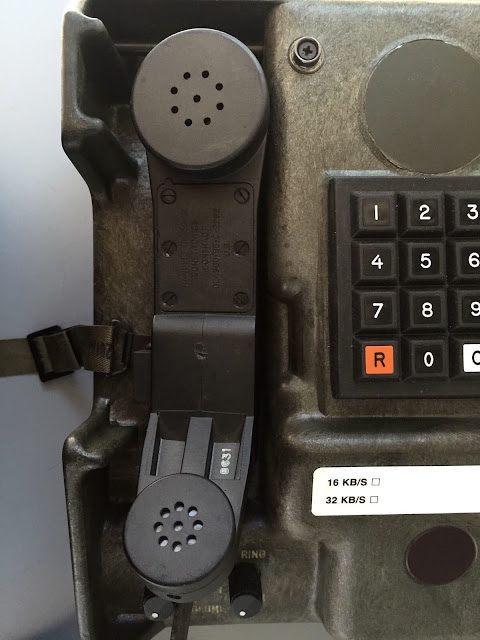Nowadays I consider to chop the plug off the cord, and trying to tear down for new converting.
The digital non-secure voice terminal (DNVT) TA-954/TT is a four-wire terminal
contained in a ruggedized case, which transmits and receives conditioned diphase-modulated
digitized voice and loop signaling information at 16 or 32 kb/s. The DNVT has a 16-key push
button keyboard, receiver and ring volume controls, an incoming call/off-hook indicator light,
and writing pad. It contains built-in protection from nuclear energy electromagnetic pulses
and lightning. Handset H-350/U is issued with the DNVT. The microphone element is
activated when the handset is removed from the cradle (hot mike). The push-to-net radio
interface switch is only pressed to key the C-6709. The DNVT provides a digital
communications interface with Tri-Service Tactical Communications (TRI-TAC) and Mobile
Subscriber Equipment (MSE) circuit switches.
Technical Characteristics :
Channel Interface-Field Wire .................... 4-wire field cable
Transmission Range................................... 4 km (2.4 mi) max
Input Power-Power Drain:
On Hook .................................................... 300 mW, max
Off Hook..................................................... 1.5 W, max
Power Requirement .................................. +24 to +56 V DC
Line Impedance ........................................ 125 ohm
Tone Pad.................................................... Characters 0-9, FO-F-I-P-R-O-C
Current Drain:
On Hook.................................................... 12.5 Ma, +24 V DC, 5.0 Ma, +56 V DC
Off Hook ................................................... 62 Ma, +24 V DC, 25 Ma, +56 V DC
Weight....................................................... 2.7 kg (5.8 lb)
TA-954/TT ID card
Left side are interface connectors and 16/32K B/S Rate switch,and 4 XMT/RCV binding posts.
Bottom side
Handset of H-350/U with 6 I-type screws, not easy to open the handset case.With Amphenol
6 Way Cable Mount Connector
All 10 screws are un-hooked and the sockets are essentially impossible to purchase in separately. But would just be easier to tear-down a compatible field telephone. So upon the TA-954/TT here by is to recover that neat-looking keypad.
None of the screws are hidden under stickers, and they are all thread into brass insertions. Pretty good concern.
in extremely sandy conditions also would be shot at occasionally.
The electronics components are protected from environmental incursion by an amusingly convoluted seal,
which are lubricated with amazingly tenacious grease. On the left side, all the interface components with the main board and line terminals on right side.
The round shape device is the metal ring speaker.
None of the screws are hidden under stickers, and they are all thread into brass insertions. Pretty good concern.
Modification on military equipment is quite interesting.
Unlike consumer electronics device, military designers know that MIL products will be used by menin extremely sandy conditions also would be shot at occasionally.
The electronics components are protected from environmental incursion by an amusingly convoluted seal,
which are lubricated with amazingly tenacious grease. On the left side, all the interface components with the main board and line terminals on right side.
The round shape device is the metal ring speaker.
The interface electronics components are pretty standard but all the military grades.
the rectangular board on the upper left side might be some sort of hangup sensor,
and the pots on the upper right are volume controller.
Lower middle side is the keypad, which appears to be secured with four (metric) nuts,
then glued down. Lower right side is a visual ring indicator.
What a cool older 80s electronics design with lots of discrete ccomponents.
Everything is coated with a waterproofing and anti-corrosion varnish,
* The enormous 8-bit 8051 microcontroller with 2.048 MHz round Oscillator.
* Texas Instruments' general metal diodes and Motorola metal small-signal transistors are found.
Input Tr and output Tr are set as bigger pair,moreover the ring type inductor is designed picked up.
The main board is connected to other sub-module boards through a 40-pin ribbon connector/cable.
Look over the board, no RF shielding or optoisolators cab be found,
which means that designer didn't concern the EMP harden factors but the case metal material can provide EMC/EMI protection.
Since in operation the TA-954 field telephone would be connected to hundreds of meters using telephone cable.
The socket appears to be molded into the case, but is impossible to liberate without extensive surgery.
So will try my hand at splicing a field telephone cable.
Main Control PCB Top
Main PCB Botom
Turns out that !
These look like a bunch of beefy inductors and zener diodes.
They probably kill surges and line noise,
since there's nothing like a faraday cage in evidence,
and there is multiple unshielded penetrations through the casing.
(Such as volume controls, keypad, etc)
Main MCU and 2.048MHz Oscillator ,especially for transmits and receives conditioned
diphase-modulated digitized voice and loop signaling information at 16 or 32 kb/ s.
Input and Output Transformers
Interface Board Top
Interface Bottom
Hand Set On-Hook Sense Board
Incoming LED Indicator TOP
Incoming LED Bottom
Outer 4X4 Keypad Module
Keypad Bottom of 4-Row / 4-Col w/o ground signal flying
Keypad Matrix Table and Pinout
Vintage Magnavox Ringing Speak
Ringing Speak Bottom
XMT & RCV Block/Red binding heavy duty posts
Beating on the handset socket some more revealed that it was actually screwed into the case,
not molded into it.
My next step is to convert it with "used" home-style telephone boards ,
modify / adapt some man-made PCBs for the keypad / interface / ringing indicator circuits!






























沒有留言:
張貼留言